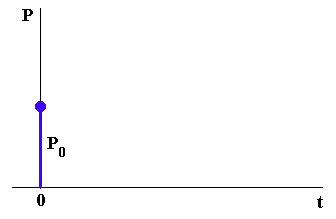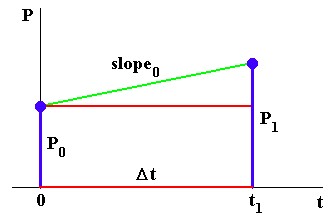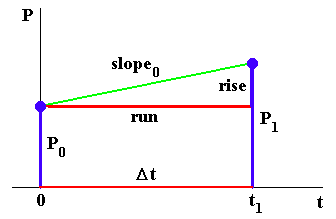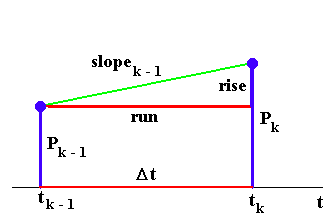|
|
|
|
|
|
Part 2: Stepping Out: Rise = Rate x Run
Here is our procedure for generating a solution function P = P(t) for the initial value problem
Starting from the known value P0, we will generate a set of values
P0 , P1 , P2 , P3 , ..., Pn
at corresponding times
0 , t1 , t2 , t3 , ..., tn ,
where the times are equally spaced at (small) steps of Delta-t. In brief, we will use the fact that we know both P and dP/dt at time 0 to calculate a rise from P0 to P1. Once we have a value for P1, we can find a slope at that point as well, so we can repeat the procedure to find P2. Continuing in the same way, we can find as many values of P as we like. As we will see, the success of this procedure depends on how small our step sizes are, and, in any case, this is an approximation procedure, because we are using instantaneous rates of change as if they stay unchanged over each interval of length Delta-t.
We illustrate the procedure graphically. The following diagram shows a graph of the starting situation. Plotting population as the dependent variable and time as the independent variable, the initial population P(0) is represented by a vertical line segment of length P(0) at the starting time t = 0.

Now we step forward in time to t1 = Delta-t. We use the slope at time 0, which we call slope0, to draw a line from (0, P0) to (t1, P1):

The slope of a line segment is the rise divided by the run, so the rise is the slope times the run. In our situation, the run is Delta-t, so
rise = slope0 x Delta-t.

The line segment representing P1 is the sum of two pieces, one of length P0, and the other of length rise = slope0 x Delta-t. Hence
P1 = P0 + slope0 x Delta-t.
Now enter the following formulas in your worksheet.

Great! It looks like we have a wonderful recursion relation for computing Pk from Pk-1, except for one little problem: What is slope0? More generally, what is slopek-1 for k = 1, 2, ... ? Answer: This is where our Theoretical Assumption from the Part 1 enters the picture! The assumption gives us a formula for the rate of change of population (the slope!) in terms of the current population.
We thus have an interesting interweaving -- we have to compute our quantities in the following order:
P0 , slope0, P1, slope1, P2, slope2, P3, slope3, ..., Pn, slopen.
We will put our formulas to use in the next Part.
|
|
|
Last modified: September 20, 1997